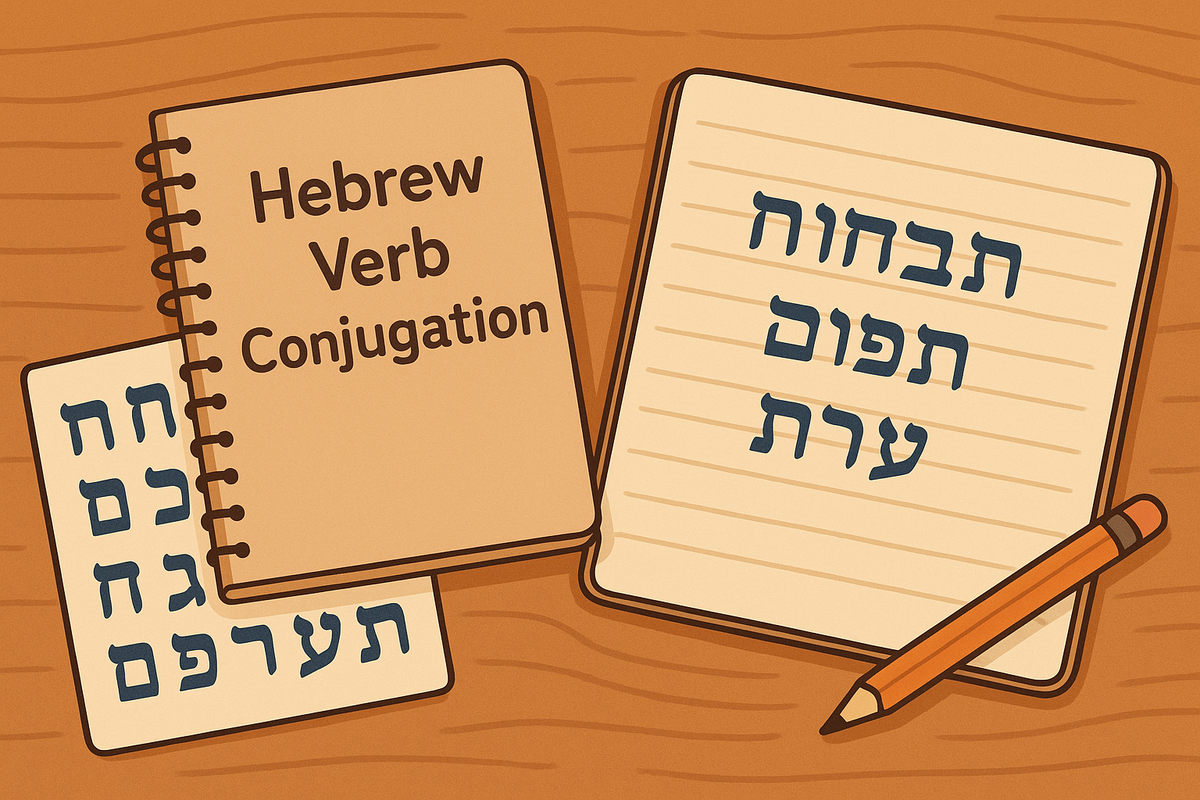Hebrew Verb Conjugation: Beginner's Guide
Unlock the secrets of Hebrew verb conjugation with essential patterns and practical tips for effective learning.

Want to learn Hebrew verbs quickly? Here's the key: Hebrew verbs are built on three-letter roots (Shorashim) and follow seven patterns (Binyanim). Mastering these patterns lets you conjugate verbs logically without memorizing endless forms.
What You'll Learn:
- Roots & Patterns: Understand how roots like כ.ת.ב (write) transform into verbs and nouns.
- 7 Verb Patterns: Learn the roles of Pa'al, Nif'al, and others for active, passive, and reflexive actions.
- Present Tense Basics: Conjugate verbs by gender and number, e.g., כותב (kotev, he writes), כותבת (kotevet, she writes).
- Tips & Tools: Use apps like Duolingo and flashcards for faster learning.
Focus on the Pa'al pattern first - it covers many everyday verbs. Ready to dive in? Let’s break it down step by step.
Hebrew Root System Basics
3-Letter Roots Explained
Hebrew verbs are built on three-letter roots known as Shorashim (שורשים). These roots act as the core "building blocks" of Hebrew words, carrying their fundamental meaning. For instance, the root כ.ת.ב (k.t.b), which means "writing", forms words like כָּתַב (katav, he wrote) and מִכְתָּב (michtav, letter). Understanding this system is key to mastering verb conjugation.
From Roots to Words
Roots are transformed into words by applying specific patterns. Take the root ל.ב.ש (l.b.sh), which relates to wearing or clothing. Here's how it works:
| Root Form | Word Created | Meaning |
|---|---|---|
| לָבַש | lavash | he wore |
| לְבוּשׁ | l'vush | clothing |
| לוֹבֵש | lovesh | wearing |
These transformations occur through the use of vowels, prefixes, and suffixes, which modify the root systematically. Hebrew roots fall into three categories:
- Strong roots: Keep all their letters intact during conjugation.
- Weak roots: May lose one or more letters in certain forms.
- Hollow roots: Often lose their middle letter during conjugation.
With this foundation, we can now dive into how these roots combine with verb patterns to create conjugated forms.
Understanding Hebrew Verbs - The Binyanim explained visually!
The 7 Verb Patterns in Hebrew
Now that we've looked at how roots work, let's dive into how they combine with verb patterns to form conjugated verbs.
All 7 Patterns at a Glance
Hebrew verbs are built around seven patterns called binyanim (בניינים). Each pattern has a specific role in expressing different types of actions. These patterns pair with the three-letter roots we discussed earlier to create precise meanings for verbs.
Here's an overview of the seven patterns:
| Pattern | Purpose | Example Using Root כ.ת.ב (write) |
|---|---|---|
| Pa'al | Simple active actions | כָּתַב (katav) - wrote |
| Nif'al | Passive or reflexive actions | נִכְתַּב (nichtav) - was written |
| Pi'el | Intensive active actions | כִּתֵּב (kitev) - corresponded |
| Pu'al | Intensive passive actions | כֻּתַּב (kutav) - was composed |
| Hif'il | Causative active actions | הִכְתִּיב (hichtiv) - dictated |
| Hof'al | Causative passive actions | הֻכְתַּב (huchtav) - was dictated |
| Hitpa'el | Reflexive intensive actions | הִתְכַּתֵּב (hitkateiv) - corresponded with |
Starting with 3 Main Patterns
For beginners, it's helpful to focus on the three most common patterns. These provide a solid base for everyday Hebrew.
- Pa'al is the most frequently used and expresses simple actions.
- Nif'al is marked by the נִ (ni) prefix and conveys passive or reflexive meanings.
- Pi'el adds intensity to the root meaning, often doubling middle letters.
Here are examples of each:
Pa'al:
- לָבַש (lavash) - he wore
Nif'al:
- נִכְתַּב (nichtav) - it was written
Pi'el:
- כִּתֵּב (kitev) - corresponded
With these basics in mind, we can now move on to see how these patterns work in the present tense.
Present Tense Verbs
Learning the present tense is an essential part of developing your Hebrew language skills. It’s the backbone of everyday conversations and helps you express actions happening now. In Hebrew, the present tense is called הווה (hove) and follows specific patterns based on gender and number.
How Present Tense Works
In Hebrew, present tense verbs have four forms to align with the gender and number of the subject:
| Form | Hebrew | Pronunciation | English |
|---|---|---|---|
| Masculine Singular | כּוֹתֵב | kotev | he writes |
| Feminine Singular | כּוֹתֶבֶת | kotevet | she writes |
| Masculine Plural | כּוֹתְבִים | kotvim | they write (m) |
| Feminine Plural | כּוֹתְבוֹת | kotvot | they write (f) |
Common Verbs Guide
Here are some commonly used verbs in their present tense forms:
- To Study (ללמוד): לומד (lomed, masculine), לומדת (lomedet, feminine), לומדים (lomdim, masculine plural), לומדות (lomdot, feminine plural)
- To Eat (לאכול): אוכל (ochel, masculine), אוכלת (ochelet, feminine), אוכלים (ochlim, masculine plural), אוכלות (ochlot, feminine plural)
Special Cases to Know
Some verbs in Hebrew don’t follow the standard patterns. Here are a few exceptions and unique rules to keep in mind:
-
Guttural Letters
Verbs with guttural letters like א, ה, ח, and ע may have slight vowel changes. For example, the root א.כ.ל (a.k.l, meaning "to eat") becomes אוכל (ochel). -
Binyan-Specific Changes
The binyan (verb pattern) determines how a verb is conjugated in the present tense:- Pa'al verbs: These follow the standard pattern (e.g., כּוֹתֵב, kotev - writes).
- Nif'al verbs: These include a נִ (ni) prefix (e.g., נִכְתָּב, nichtav - is written).
- Pi'el verbs: These double the middle root letter (e.g., מְדַבֵּר, medaber - speaks).
-
Irregular Verbs
Some verbs, like "to want" (רצה), have unique conjugations: רוֹצֶה (rotse, masculine singular), רוֹצָה (rotsa, feminine singular), רוֹצִים (rotsim, masculine plural), and רוֹצוֹת (rotsot, feminine plural).
With these rules and examples, you’re ready to dive into practicing present tense verbs and applying them in everyday Hebrew conversations!
Learning Methods and Tools
Mastering Hebrew verb conjugation becomes simpler with the right strategies and resources. Here’s how you can strengthen your skills effectively.
Practical Tips for Learning
Pay attention to sound patterns to make conjugations easier. Instead of memorizing every verb form, focus on patterns like o-e-et, which repeat across many verbs. Use flashcards to organize your learning. Each card should include:
- The verb's root
- Present tense forms
- Examples of common usage
- Related verbs with similar patterns
This approach helps you see connections and reinforces your memory.
Apps and Charts to Support Learning
Take advantage of digital tools to speed up your progress:
| App Name | Features |
|---|---|
| Duolingo | Fun, gamified lessons for basic conjugations |
| Pimsleur | Audio lessons led by native speakers |
| baba | Real-time translations with gender-specific insights |
| Anki | Custom flashcards with progress tracking |
For deeper reference materials, Reverso Conjugator and The Kefar's Guide to Hebrew Verb Conjugations offer detailed verb tables and practice exercises.
Practice Guidelines
Immerse yourself in Hebrew by watching Israeli TV shows with subtitles. Spend 15-20 minutes daily on focused practice. Apps like HelloTalk let you connect with native speakers who can provide real-time feedback on your verb usage. Regular exposure to native content not only strengthens your conjugation skills but also boosts overall language comprehension.
Wrap-Up
Key Takeaways
Hebrew verbs are built on three main components: roots, patterns (binyanim), and conjugation rules. These parts work together in a structured way, with roots and binyanim forming the framework for verbs. In the present tense, verb forms vary based on gender and number, including specific forms for masculine, feminine, singular, and plural subjects [1][2].
Now that you have a grasp of these basics, let’s look at how to keep improving.
Next Steps
With the essentials of roots, patterns, and present tense conjugation in mind, focus on one pattern at a time. Start with the Pa'al pattern, which covers many basic actions [3]. Build a daily routine that includes:
- 15 minutes practicing conjugations with Reverso Conjugator
- 20 minutes reading Israeli news for practical exposure
- 10 minutes reviewing patterns using Cooljugator
Reverso Conjugator offers detailed verb tables, while The Kefar's "Hebrew Verb Conjugations" guide provides structured support [3]. By combining regular practice with exposure to authentic Hebrew content, you'll strengthen your understanding of verb patterns and how to use them effectively in everyday situations.





